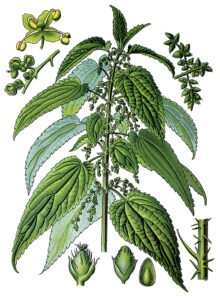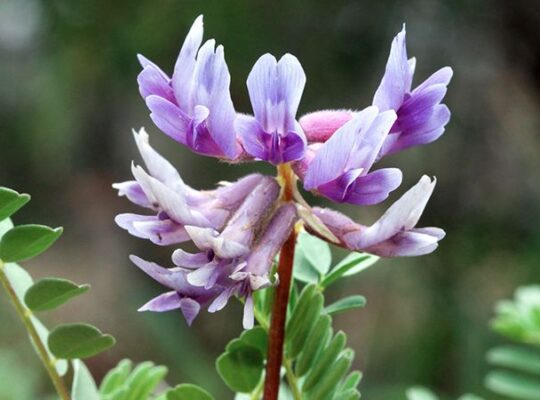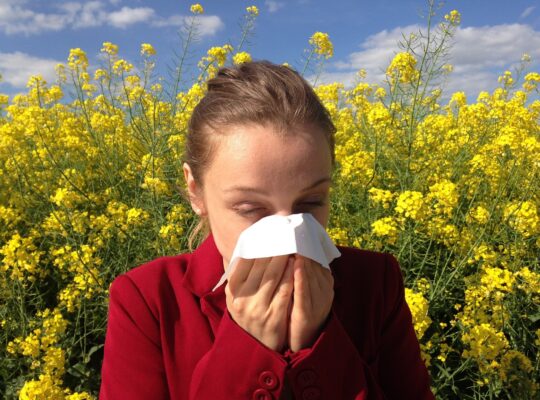
PHYLOGENETIC INFORMATION:
- Phylum: Angiosperm
- Class: Eudicot
- Family: Urticaceae
- Genus: Urtica
- Species: Urtica dioica
- Common Names: Nettle, Common Nettle, Nettle Leaf
A flowering plant, Urtica dioica, better known as Stinging Nettle (or Nettle), falls within the Urticaceae family, the Urtica genus, and the dioica species. U. dioica consists of 45 genera and 550 species worldwide with only six genera in North America. (“Leftovers”)
BOTANICAL INFORMATION:
Native to Eurasia, U. dioica is cultivated in most of the United States (except Arkansas) and abroad specifically in New Zealand, Turkey, Scotland, Denmark, and Norway. (Bakhshaee, Kreigel. “Nettles”) It is a dioecious, herbaceous, and perennial plant that thrives in damp, dark, and nitrogen-rich soils, blooming June to September and growing between 3-9 feet. (“Nettles”)
It consists of elongated, heart-shaped leaves with serrated margins (“Leftovers”), growing opposite of each other. At the top, it has a narrow leaf pattern, which spreads out as it goes down. Along its leaf’s axis are petal-less, clusters of male and female (white and green) flowers. The male flowers typically consist of four stamens, growing in “diagonally upright clusters”; whereas, the female flowers droop as they grow. (“Nettle” [Plant]) Both its leaves and flowers extend from long, hairy, squarish-shaped stems.
U. dioica got its name due to its needle-like stingers on its leaves and stem. The stingers are what separates it from its look-alike, Lamium album (commonly known as white nettle). (“Urtica”) Even when lightly touched, U. dioica’s sting often followed by a mild rash starts within a few hours and could last for several days. That sting is possible due to some of its constituents like “histamine, acetylcholine, 5-hydroxytryptamine, small amounts of formic acid, leukotrienes, and other components,” triggering a neutrotransmitter response. (Foster)
One should always use extreme caution when collecting Nettle, preferably by wearing appropriate clothing like pants and a long-sleeved shirt plus be equipped with gloves, clippers, and a suitable carrying container. Once nettle has dried (or has been cooked), its leaves “lose their sting.” (“Nettles”)
The best time to harvest its leaves is in the early Spring while they are still quite young (roughly 10-12 inches tall) and before they flower in the late Spring, early Summer. (“Nettle” [Plant]) Again, one should avoid coming into direct contact with fresh nettle without proper protective gear. It’s always best to “use scissors to clip the stems just above the leaf node,” which actually helps its continued growth. (“How to“)
HERBAL INFORMATION:
Energetically speaking, U. dioica’s leaves have a salty taste profile and a drying, cooling, and moisturizing effect. Meanwhile, its roots are bland.
“Nettle leaf is a micronutrient dense, nutritious food” full of “calciumCalcium is a vital mineral essential for various physiological functions in the body, with its primary role centered around bone health and proper functioning of the nervous and muscular systems., manganese, magnesiumMagnesium is a crucial mineral that plays a fundamental role in numerous biochemical processes essential for overall health. It is integral to muscle and nerve function, supporting proper muscle contractions, vitamin KVitamin K is essential for blood clotting, bone health, and overall cardiovascular well-being. It plays a crucial role in the synthesis of proteins responsible for blood clotting and preventing excessive, and carotenoids, and protein.” supplying “high amounts of chlorophyll, insoles, including histamine and serotonin, acetylcholine, vitamin CVitamin C, also known as ascorbic acid, is a water-soluble vitamin with a multitude of essential functions in the body. Renowned for its powerful antioxidant properties, Vitamin C helps protect, A, and other important vitamins, silicon, potassiumPotassium is an essential mineral that plays a critical role in maintaining proper fluid balance, nerve signals, and muscle contractions within the body. As an electrolyte, potassium works in tandem, protein and fiber.” (“Stinging Nettle,” “Urtica”, Tierra) However, its nutrient qualities vary based on a number of factors, such as its “variety, genotype, climate, soil, vegetative state, harvest time, storage, processing and treatment.” (Kregiel)
Its herbal actions are alterative, alkalinizing diuretic, antioxidant, astringent (root), nutritive, anti-inflammatory, urinary tract tonic, along with circulatory stimulant – blood purifier and builder, promotes milk production/flow (in nursing mothers), lowers blood sugar levels (diabetes), [and] prevents scurvy (“Herbalepdia”, Tilgner)
In general, U. dioica is used to “strengthen the kidneys, treatment of rheumatism, gout, anemia, and hay fever.” {“Nettle” [Plant]) Its also used for eczema, hypothyroidism, UTIs, bronchia and asthma, menstrual cramps, pregnancy, and postpartum support, osteoarthritis, menopause, inflammation, type 2 diabetes, and [enlarged] prostate” (Foster, “Herbalpedia”, Kargozar, “Nettle”, “Stinging Nettle”)
Unfortunately, most US-based clinical studies regarding its effectiveness are typically limited to animal (or in-vitro) studies (on rats); however, human trials are performed as it relates to BPH. The majority of human clinical trials conducted using U. dioica were performed by researchers in foreign lands.
A 1990 state-side study, it was observed the anti-inflammatory effects of U. dioica as it relates to hay fever sufferers. In the three years prior to that study, patients could obtain “a freeze-dried preparation of the herb” either as a prescription or over the counter. In that study, sixty-nine patients completed a double-blind, randomized study on its effectiveness. Some were provided with “600 mg freeze-dried nettle leaf daily,” while others were provided a placebo.
Few differences were noticed in patient daily journal entries; however, by its conclusion, “the study showed differences between Urtica dioica and placebo when participants were asked to compare the medicines to previous medications, and whether the participant would buy the medicine for future use.” (Mittman) Overall, “Fifty-eight percent reported relief of most symptoms and 48 percent stated it was more effective than other over-the-counter medications.” (Urtica)
Switching gears, as a blood builder, U. dioica is believe to boost ironIron is a crucial mineral with a primary role in transporting oxygen throughout the body via hemoglobin, a component of red blood cells. This oxygen transport is vital for energy levels and decrease fatigue in those who are anemia. It can be used as an alternative to iron supplements during the early stages of pregnancy and a source of nutrition throughout one’s pregnancy. (“Stinging Nettle”) Also, women who regularly consume suggested doses of “nettle infusions can restore mineral reserves and relieve menstrual or leg cramps.” (“Stinging Nettle”)
As a diuretic, U. dioica helps to “drain congested fluids in the body.” Nettle is great at “tonifying and strengthening…the urinary system” and thus, it’s great for urinary tract infections (or UTIs). As an adaptogen, Nettle seeds are beneficial in supporting kidney health, helping with “general stress response” as it “strengthens the adrenals.” (“Stinging Nettle”)
“Herbalist Jonathan Treasure reports that he regularly employs nettle seed in renal-protective protocols in patients who are undergoing chemotherapy with platinum drugs (which are known for damaging kidney health [as measured by serum creatinine levels].” (“Stinging Nettle”) Furthermore, the Nettle root [extract] serves as an astringent and thus has been clinically proven to reduce benign prostatic hyperplasia (BHP) – a precursor to prostate cancer. (Ghorbanibirgani)
In a 2011 clinical trial of one hundred Iranian men aged 40-80, that study showed a significant decrease in prostate symptoms – such as “reduce urinary flow, incomplete emptying of the bladder, post urination dripping, and the constant urge to urinate with use of Nettle root” – among those who took nettle extract. (Ghorbanibirgani, Tilgner) One group of fifty was given 300 mg capsules (2x/day) while the remainder were given a placebo. Among those taken who take the Nettle capsules, the average score of [Prostate Symptom Score] was assessed 26.511±0.264 and 2.118±0.431 (P = 0.000) and in the placebo group, 27.854±0.744 and 27.853±0.766.” (Ghorbanibirgani)
Depending on the need, all of the U. dioica are usable from its young leaves to its seeds and roots. When nettle leaves are cooked fresh “or mashed to a fine pulp while raw,” they are great in soups, stir-fry, and steaming. (“Nettle” [Plant], Tilgner)
Its aerial parts can also be taken internally as a nourishing infusion (for arthritis, rheumatism, gout, and eczema), as a tincture (for skin issues and heavy uterine bleeding or its seeds as a “kidney trophorestorative”), in juice (for cardiac insufficiency with edema) or as a decoction (of its root for enlarged prostate issues).
Externally, it could be used as a compress (for arthritis and gout), ointment (for hemorrhoids), wash (for bites and wounds), powder (for nosebleeds), and decoction (for scalp conditions including dandruff. (“Herbalpedia”)
Although it’s best consumed as a spring tonic, below are suggested dosages, especially since consumption of U. dioica in large doses could be “contraindicated during pregnancy due to emmenagogue and abortifacient effects.” (“Stinging Nettle,” “Urtica”, Tilgner) Per the Botanical Safety Handbook (2nd ed.), there are no known drug or supplement interactions with U. dioica.
Recommended Dosages:
- Nettle leaf infusion: up to 1 ounce (30 grams) of dried herb into tea per day; can be steeped overnight to extract more minerals
- Fresh nettle tincture: (1:2, 50-90% alcohol) 60-90 drops 3-7 times per day
- Nettle root (decoction or powdered): 6-9 grams
- Nettle root tincture: (1:5, 30% alcohol, dried root): 2-3 mL, three times a day
- Nettle seed: 1-2 grams (1-2 teaspoons up to 1-2 tablespoons) per day
- Nettle seed tincture: (1:5, 30% alcohol, ripe seed): 1.5-2 mL, three times a day
SOURCES:
Bakshaee, Mehdi et al. “Efficiacy of Supportive Therapy of Allergic Rhinitis by Stinging Nettle (Urtica dioica) root extract: a Randomized, Double-Blind, Placebo-Controlled, Clinical Trial.”
Iranian Journal of Pharmaceutical Research vol. 16, Suppl (2017): 112-118.
Foster, Steven, & Duke, James A. (2014). Peterson Field Guide to Medicinal Plants and Herbs of Eastern and Central North America. New York: Houghton Mufflin.
Ghorbanibirgani, Alireza et al. “The efficacy of stinging nettle (Urtica dioica) in patients with benign prostatic hyperplasia: a randomized double-blind study in 100 patients.” Iranian Red
Crescent Medical Journal vol 15,1 (2013):9-10. doi:10.5812/ircmj.2386
“How to Make Herbal Vinegars.” HerbMentor. https://herbmentor.learningherbs.com/articles/remedies-recipes/herbal-vinegars/ Accessed 25 Sept 2021.
Kargozar, Rahele et al. “Urtica Dioica in comparison with placebo and acupuncture: A new possibility for menopausal hot flashes: A randomized clinical trial.” Complementary
therapies in medicine vol. 44(2019): 166-173. doi:10.1016/j.ctim.2019.04.003.
Mittman P. Randomized, Double-Blind Study of Freeze-Dried Urtica dioica in the Treatment of Allergic Rhinitis. Townsend Letter for Doctors & Patients. 1991;(91/92):99. Accessed
September 26, 2021. https://search.ebscohost.com/login.aspx?direct=true&db=awh&AN=6210410&site=ehost-live
“Nettle.” Plant Walks. https://herbmentor.learningherbs.com/plantwalks/nettle-plant-walk-4/
“Nettle Herb.” Herbs with Rosalee. https://www.herbalremediesadvice.org/nettle-herb.html. Accessed 23 Sept. 2021.
“Nettle Reduces Menopause Symptoms.” The Journal of Chinese Medicine. 121, 2019. 79.
“Nettle Shake.” HerbMentor. https://herbmentor.learningherbs.com/articles/remedies-recipes/nettle-shake/. Accessed 25 Sept 2021.
“Nettles.” Herbalpedia. https://www.herbworld.com. Accessed 14 Sept. 2021.
“Romania: Urzicicu Orez la Cuptor (Baked Rice with Nettles).” AtoZ World Food Database. Accessed 25 Sept 2021. https://www.atozworldfood.com/romania/side-dishes/urzicicuorez-la-cuptor-baked-rice-with-nettles.html
“Stinging Nettle: Urtica spp.” HerbMentor. https://herbementor.learningherbs,com/herb/stinging-nettle/. Accessed 14 Sept. 2021.
“The Leftovers (Part 1)”. HerbMentor: Learning Your Plants. https://herbmentor.learningherbs.com/course/learning-your-plants/module-2-lesson-19/. Accessed 24 Sept. 2021.
Tierra, Michael (1998). The way of herbs. New York: Pocket.
Tilgner, Sharon (2018). Herbal ABC’s: The Foundation of Herbal Medicine. Pleasant Hills, OK; Wise Acres.
“Urtica dioica; Urtica urens. (Nettle).” Alternative Medicine Review. 2007;12(3):280-284.




